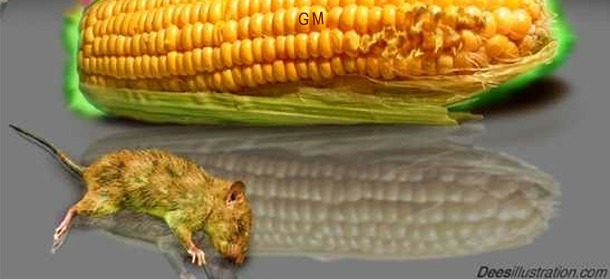Featured
10 Reasons Why GM Foods Are Just Plain Wrong
Genetically modified foods are nearly impossible to avoid in the US—and the EU is on the verge of following suit. But nothing we’re officially told about GM foods’ safety is true, and the rest of the claims are all demonstrably false. Please, be sure that you know the truth and then get active to end this destruction of our food supply.
from GM Watch
If you want to print this article as an A4 leaflet, download a PDF.
Genetically modified (GM) foods are often promoted as a way to feed the world. But this is little short of a confidence trick. Far from needing more GM foods, there are urgent reasons why we need to ban them altogether.
1. GM foods won’t solve the food crisis
A 2008 World Bank report concluded that increased biofuel production is the major cause of the increase in food prices.[1] Biofuels are crops grown for fuel rather than food. GM giant Monsanto has been at the heart of the lobbying for biofuels — while profiting enormously from the resulting food crisis and using it as a PR opportunity to promote GM foods!
“The climate crisis was used to boost biofuels, helping to create the food crisis; and now the food crisis is being used to revive the fortunes of the GM industry.” — Daniel Howden, Africa correspondent, The Independent (UK)[2]
“The cynic in me thinks that they’re just using the current food crisis and the fuel crisis as a springboard to push GM crops back on to the public agenda. I understand why they’re doing it, but the danger is that if they’re making these claims about GM crops solving the problem of drought or feeding the world, that’s bullshit.” – Prof Denis Murphy, head of biotechnology, University of Glamorgan, Wales[3]
2. GM crops do not increase yield potential
Despite the promises, GM has not increased the yield potential of any commercialised crops.[4] In fact, studies show that the most widely grown GM crop, GM soya, has suffered reduced yields.[5]
A report that analyzed nearly two decades worth of peer reviewed research on the yield of the primary GM food/feed crops, soybeans and corn (maize), reveals that despite 20 years of research and 13 years of commercialization, genetic engineering has failed to significantly increase US crop yields. The author, former US EPA and US FDA biotech specialist Dr Gurian-Sherman, concludes that when it comes to yield, “Traditional breeding outperforms genetic engineering hands down.”[6]
“Let’s be clear. As of this year [2008], there are no commercialized GM crops that inherently increase yield. Similarly, there are no GM crops on the market that were engineered to resist drought, reduce fertilizer pollution or save soil. Not one.” – Dr Doug Gurian-Sherman[7]
3. GM crops increase pesticide use
US government data shows that in the US, GM crops have produced an overall increase, not decrease, in pesticide use compared to conventional crops.[8]
“The promise was that you could use less chemicals and produce a greater yield. But let me tell you none of this is true.” – Bill Christison, President of the US National Family Farm Coalition[9]
4. There are better ways to feed the world
A major UN/World Bank-sponsored report compiled by 400 scientists and endorsed by 58 countries concluded that GM crops have little to offer global agriculture and the challenges of poverty, hunger, and climate change, because better alternatives are available. In particular, the report championed “agroecological” farming as the sustainable way forward for developing countries.[10]
5. Other farm technologies are more successful
Integrated Pest Management and other innovative low-input or organic methods of controlling pests and boosting yields have proven highly effective, particularly in the developing world.[11] Other plant breeding technologies, such as Marker Assisted Selection (non-GM genetic mapping), are widely expected to boost global agricultural productivity more effectively and safely than GM.[12] [13]
“The quiet revolution is happening in gene mapping, helping us understand crops better. That is up and running and could have a far greater impact on agriculture [than GM].” – Prof John Snape, head of the department of crop genetics, John Innes Centre[14]
6. GM foods have not been shown to be safe to eat
Genetic modification is a crude and imprecise way of incorporating foreign genetic material (e.g. from viruses, bacteria) into crops, with unpredictable consequences. The resulting GM foods have undergone little rigorous and no long-term safety testing. However, animal feeding tests have shown that GM foods have toxic effects, including abnormal changes in organs, immune system disturbances, accelerated ageing, and changes in gene expression.[15] Very few studies have been published on the direct effects on humans of eating a GM food. One such study found unexpected effects on gut bacteria, but was never followed up.[16]
It is claimed that Americans have eaten GM foods for years with no ill effects. But these foods are unlabeled in the US and no one has monitored the consequences. With other novel foods like trans fats, it has taken decades to realize that they have caused millions of premature deaths.[17]
“We are confronted with the most powerful technology the world has ever known, and it is being rapidly deployed with almost no thought whatsoever to its consequences.” — Dr Suzanne Wuerthele, US Environmental Protection Agency (EPA) toxicologist
7. People don’t want GM foods – so they’re hidden in animal feed
As a spokesperson for Asgrow, a subsidiary of Monsanto, said, “If you put a label on genetically engineered food, you might as well put a skull and crossbones on it.”[18] The GM industry has got around the problem of consumer rejection of GM foods by hiding them in animal feed. Meat, eggs and dairy products from animals raised on the millions of tons of GM feed imported into Europe do not have to be labelled. Some studies show that contrary to GM and food industry claims, animals raised on GM feed ARE different from those raised on non-GM feed.[19] Other studies show that if GM crops are fed to animals, GM material can appear in the resulting products[20] and affect the animals’ health.[21] So eating these “stealth GMOs” may affect the health of consumers.
8. GM crops are a long-term economic disaster for farmers
A 2009 report showed that GM seed prices in America have increased dramatically, compared to non-GM and organic seeds, cutting average farm incomes for US farmers growing GM crops. The report concluded, “At the present time there is a massive disconnect between the sometimes lofty rhetoric from those championing biotechnology as the proven path toward global food security and what is actually happening on farms in the US that have grown dependent on GM seeds and are now dealing with the consequences.”[22]
9. GM and non-GM cannot co-exist
GM contamination of conventional and organic food is increasing. An unapproved GM rice that was grown for only one year in field trials was found to have extensively contaminated the US rice supply and seed stocks.[23] In Canada, the organic oilseed rape industry has been destroyed by contamination from GM rape.[24] In Spain, a study found that GM maize “has caused a drastic reduction in organic cultivations of this grain and is making their coexistence practically impossible”.[25]
The time has come to choose between a GM-based, or a non-GM-based, world food supply.
“If some people are allowed to choose to grow, sell and consume GM foods, soon nobody will be able to choose food, or a biosphere, free of GM. It’s a one way choice, like the introduction of rabbits or cane toads to Australia; once it’s made, it can’t be reversed.” – Roger Levett, specialist in sustainable development[26]
10. We can’t trust GM companies
The big biotech firms pushing their GM foods have a terrible history of toxic contamination and public deception.[27] GM is attractive to them because it gives them patents that allow monopoly control over the world’s food supply. They have taken to harassing and intimidating farmers for the “crime” of saving patented seed or “stealing” patented genes — even if those genes got into the farmer’s fields through accidental contamination by wind or insects.[28]
“Farmers are being sued for having GMOs on their property that they did not buy, do not want, will not use and cannot sell.” – Tom Wiley, North Dakota farmer[29]
Sources:
1. Donald Mitchell, 2008. A Note on Rising Food Prices. World Bank.http://image.guardian.co.uk/sys-files/Environment/documents/2008/07/10/Biofuels.PDF
2. Daniel Howden, 2008. Hope for Africa lies in political reforms. The Independent, 8 September.http://www.independent.co.uk:80/opinion/commentators/daniel-howden-hope-for-africa-lies-in-political-reforms-922487.html
3. Rob Lyons, 2008. GM: it’s safe, but it’s not a saviour. Spiked Online, 7 July.http://www.spiked-online.com/index.php?/site/article/5438/
4. Jorge Fernandez-Cornejo and William D. McBride, 2002. The adoption of bioengineered crops. US Department of Agriculture Report, May.http://www.ers.usda.gov/publications/aer810/aer810.pdf
5. R.W. Elmore et al., 2001. Glyphosate-resistant soyabean cultivar yields compared with sister lines. Agronomy Journal 93, 2001: 408–412.
6. Doug Gurian-Sherman, 2009. Failure to Yield: Evaluating the Performance of Genetically Engineered Crops. Union of Concerned Scientists. http://tiny.cc/eqZST
7. Doug Gurian-Sherman, 2008. Genetic engineering — A crop of hyperbole. The San Diego Union Tribune, 18 June. http://www.signonsandiego.com/uniontrib/20080618/news_lz1e18gurian.html
8. Charles Benbrook, Ph.D., 2009. Impacts of Genetically Engineered Crops on Pesticide Use: The First Thirteen Years. The Organic Center, November. http://www.organic-center.org/science.pest.php?action=view&report_id=159
9. Bill Christison, 1998. Family Farmers Warn of Dangers of Genetically Engineered Crops. In Motion magazine, 29 July. http://www.inmotionmagazine.com/genet1.html
10. N. Beintema et al., 2008. International Assessment of Agricultural Knowledge, Science and Technology for Development: Global Summary for Decision Makers (IAASTD).http://www.agassessment.org/index.cfm?Page=IAASTD%20Reports&ItemID=2713
11. N. Beintema et al., 2008. International Assessment of Agricultural Knowledge, Science and Technology for Development: Global Summary for Decision Makers (IAASTD).http://www.agassessment.org/index.cfm?Page=IAASTD%20Reports&ItemID=2713
12. B.C.Y. Collard and D.J. Mackill, 2008. Marker-assisted selection: an approach for precision plant breeding in the twenty-first century. Philos Trans R Soc Lond B Biol Sci 363: 557–572.
13. J.R. Witcombe et al., 2008. Breeding for abiotic stresses for sustainable agriculture. Philos Trans R Soc Lond B Biol Sci 363: 703–716.
14. John Snape, 2002. Gene mapping the friendly face of GM technology. Farmers Weekly, 1 March: 54.
15. – Memorandum to Linda Kahl on the Flavr Savr tomato (Pathology Review PR–152; FDA Number FMF–000526): Pathology Branch’s evaluation of rats with stomach lesions from three four-week oral (gavage) toxicity studies (IRDC Study Nos. 677–002, 677–004, and 677–005) and an Expert Panel’s report. F.A. Hines. US Department of Health & Human Services, 1993.
– Witness Brief – Flavr Savr tomato study in Final Report (IIT Research Institute, Chicago, IL 60616 USA) cited by Dr Arpad Pusztai before the New Zealand Royal Commission on Genetic Modification: New Zealand Royal Commission on Genetic Modification, 2000.
– V.E. Prescott, P.M. Campbell, A. Moore, et al. 2005. Transgenic expression of bean alpha-amylase inhibitor in peas results in altered structure and immunogenicity. J Agric Food Chem 53: 9023–9030.
– M. Malatesta, M. Biggiogera, E. Manuali, M.B.L. Rocchi, B. Baldelli, G. Gazzanelli, 2003. Fine structural analyses of pancreatic acinar cell nuclei from mice fed on genetically modified soybean. European Journal of Histochemistry 47: 385–388.
– M. Malatesta et al., 2002. Ultrastructural morphometrical and immunocytochemical analyses of hepatocyte nuclei from mice fed on genetically modified soybean. Cell Struct Funct 27: 173-180
– L. Vecchio et al., 2004. Ultrastructural analysis of testes from mice fed on genetically modified soybean. Eur J Histochem 48: 448-454
– M. Malatesta et al., 2008. A long-term study on female mice fed on a genetically modified soybean: effects on liver ageing. Histochem Cell Biol 130: 967-977
– S.W. Ewen and A. Pusztai, 1999. Effects of diets containing genetically modified potatoes expressing Galanthus nivalis lectin on rat small intestine. The Lancet 354: 1353–1354
– Séralini, G.-E. et al., 2007. New Analysis of a Rat Feeding Study with a Genetically Modified Maize Reveals Signs of Hepatorenal Toxicity. Arch Environ Contam Toxicol 52: 596–602.
– R. Tudisco R, P. Lombardi, F. Bovera et al., 2006. Genetically modified soya bean in rabbit feeding: Detection of DNA fragments and evaluation of metabolic effects by enzymatic analysis. Animal Science 82:193–199.
– F.B. Brasil, L.L. Soares, T.S. Faria et al., 2009. The impact of dietary organic and transgenic soy on the reproductive system of female adult rat. Anat Rec (Hoboken) 292: 587–594.
– A. Pusztai, S. Bardocz, 2006. GMO in animal nutrition: Potential benefits and risks. In: R. Mosenthin, J. Zentek, T. Zebrowska, eds. 2006. Biology of Nutrition in Growing Animals 4: 513–540.
– G.E. Séralini, D. Cellier, J. Spiroux de Vendomois, 2007. New analysis of a rat feeding study with a genetically modified maize reveals signs of hepatorenal toxicity. Archives of Environmental Contamination and Toxicology 52: 596–602.
– A. Kilic, M.T. Akay, 2008. A three generation study with genetically modified Bt corn in rats: Biochemical and histopathological investigation. Food Chem Toxicol 46: 1164–1170.
– J.S. de Vendomois, F. Roullier, D. Cellier, G.E. Séralini, 2009. A comparison of the effects of three GM corn varieties on mammalian health. Int J Biol Sci 5:706–726.
– A. Finamore, M. Roselli, S. Britti S et al., 2008. Intestinal and peripheral immune response to MON810 maize ingestion in weaning and old mice. J Agric Food Chem 56: 11533–11539.
– A. Velimirov, C. Binter, J. Zentek, 2008. Biological effects of transgenic maize NK603xMON810 fed in long term reproduction studies in mice. Familie und Jugend Report, Forschungsberichte der Sektion IV Band 3/2008.
– M. Trabalza-Marinucci, G. Brandi, C. Rondini, et al., 2008. A three-year longitudinal study on the effects of a diet containing genetically modified Bt176 maize on the health status and performance of sheep. Livestock Science 113: 178–190.
16. T. Netherwood et al., 2004. Assessing the survival of transgenic plant DNA in the human gastrointestinal tract. Nature Biotechnology 22: 204–209.
17. Paula Hartman Cohen, 2006. Trans Fats: The story behind the label. Harvard Public Health Review. http://www.hsph.harvard.edu/review/rvw_spring06/rvwspr06_transfats.html
18. Anil Netto,2000. Consumer groups for mandatory labelling of GM food. IPS News, 13 March.http://www.twnside.org.sg/title/groups.htm
19. Jack A. Heinemann, PhD, 2009. Report on animals exposed to GM ingredients in animal feed. Prepared for the Commerce Commission of New Zealand, 24 July. http://bit.ly/4HcJuJ
20. – R. Sharma et al., 2006. Detection of transgenic and endogenous plant DNA in digesta and tissues of sheep and pigs fed Roundup Ready canola meal. J Agric Food Chem 54: 1699–1709.
– R. Mazza et al., 2005. Assessing the transfer of genetically modified DNA from feed to animal tissues. Transgenic Res 14: 775–784.
– A. Agodi et al., 2006. Detection of genetically modified DNA sequences in milk from the Italian market. Int J Hyg Environ Health 209: 81–88.
– T. Ran, L. Mei, W. Lei, L. Aihua, H. Ru, S. Jie, 2009. Detection of transgenic DNA in tilapias (Oreochromis niloticus, GIFT strain) fed genetically modified soybeans (Roundup Ready). Aquaculture Research 40: 1350–1357.
21. – R. Tudisco, V. Mastellone, M.I. Cutrignelli, et al., 2010. Fate of transgenic DNA and evaluation of metabolic effects in goats fed genetically modified soybean and in their offsprings. Animal 4: 1662–1671.
– Jack A. Heinemann, PhD, 2009. Report on animals exposed to GM ingredients in animal feed. Prepared for the Commerce Commission of New Zealand, 24 July. http://bit.ly/4HcJuJ
22. Charles Benbrook, 2009. The magnitude and impacts of the biotech and organic seed price premium. The Organic Center, December. http://www.organic-center.org/reportfiles/Seeds_Final_11-30-09.pdf
23. E. Neal Blue, 2007. Risky business: Economic and regulatory impacts from the unintended release of genetically engineered rice varieties into the rice merchandising system of the US. Report for Greenpeace.http://www.greenpeace.org/raw/content/international/press/reports/risky-business.pdf
24. Soil Association, 2002. Seeds of doubt: North American farmers’ experience of GM crops.http://www.soilassociation.org/seedsofdoubt
25. R. Binimelis, 2008. Coexistence of plants and coexistence of farmers: Is an individual choice possible? Journal of Agricultural and Environmental Ethics 21: 437–457.
26. Roger Levett, 2008. Choice: Less can be more. Food Ethics magazine 3: 11.http://www.foodethicscouncil.org/node/384
27. See, for example, Marie-Monique Robin’s documentary film, Le Monde Selon Monsanto (The World According to Monsanto), ARTE, 2008; and the website of the NGO, Coalition Against Bayer-Dangers, www.cbgnetwork.org
28. – BBC News Online 2000. GM firm sues Canadian farmer, 6 June.http://news.bbc.co.uk/2/hi/americas/779265.stm
– Center for Food Safety, 2007. Monsanto vs. US Farmers: November 2007 Update.Washington, DC and San Francisco, CA, November.
29. Stephen Leahy, 2004. Monsanto ”seed police” scrutinize farmers. InterPress Service, 15 January. http://www.commondreams.org/headlines05/0115-04.htm
Tagged cannot trust gm companies, environment, farm technologies, feed the world, genetic engineering, genetic modification, genetically engineered foods, genetically modified foods, gm and nongm cannot coexist, gm animal food, gm crop yield, gm food crisis, gm foods, gm foods hidden, gm foods unsafe, gm pesticide use, gmo, trust gm companies





















Pingback: 10 Reasons Why GM Foods Are Just Plain Wrong | The Old Fox River Mill Pond